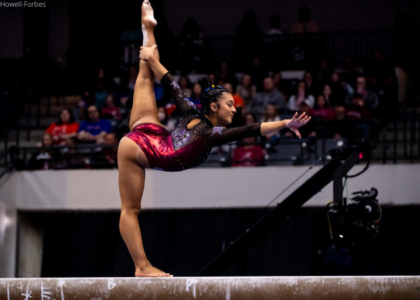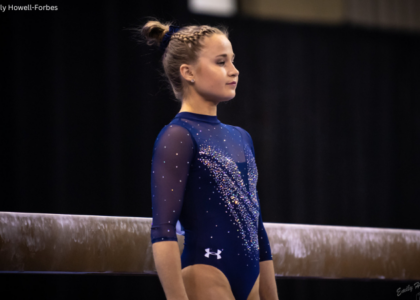There were so. many. 10s this month. But how many of them were actually worthy of a perfect score? We had 36 performances awarded 10 in March, but as fans, athletes, commentators, and seemingly everyone other than the judging panel has acknowledged, not all 10.0s are created, or distributed, equally. Here I’ll break down the deductions I saw when watching the videos in real time, and rank the 10.0 from one to five stars. As a reminder, here’s my rating scale:
⭐ This was clearly not a 10.0 routine (but still very good!)
⭐⭐ There was definitely a deduction there, but maybe the judges blinked?
⭐⭐⭐ 10.0 vibes, but not actually perfect
⭐⭐⭐⭐ It was a “college 10”
⭐⭐⭐⭐⭐ 100% a perfect routine
This is a long article but here’s a summary for you:
- On vault, there were six 10.0s awarded, with one five-star rating and an average rating of 3.5 stars.
- On bars, there were five 10.0s awarded, with no five-star ratings. The average was 3.2 stars
- On beam there were ten 10.0s awarded, with no five-star ratings. The average was 3.1 stars.
- On floor there were fifteen 10.0s awarded, with one five star rating and an average rating of 3.07 stars.
Vault
Nikki Smith, Michigan State (March 1)
Deductions
Arm bend: (-0.05)
I only caught this deduction on my second time watching the vault; it was so quick. Definitely an NCAA 10.0. Smith did a great job getting off the table, maintaining her form, and controlling her landing.
Rating: ⭐️⭐️⭐️⭐️
Makenzie Wilson, Kentucky (March 3)
Deductions
Shoulder angle (-0.05)
Excessive arch (-0.05)
Low chest on landing (-0.05)
Wilson can put on a clinic for this vault, but this was not the best one I’ve seen her do. She had some form issues on the table and landed with her chest low.
Rating: ⭐️⭐️⭐️
Haleigh Bryant, LSU (March 8)
A truly stuck Haleigh Bryant vault is almost always a 10.0 in my book. She does it better than anyone else.
Rating: ⭐️⭐️⭐️⭐️⭐️
Luisa Blanco, Alabama (March 8)
Deductions
Toes/legs crossed (-0.05)
hop/lack of control on landing (-0.05)
OK, so stay with me here. The code specifically says that there is “no deduction for feet a maximum of hip-width apart, provided heels join (slide) together on the controlled extension. Here, her feet slightly hop together into the extension, and she doesn’t ever show control over her landing before moving into the extension position. Blanco is not the only athlete I’ve seen use this technique, but in my opinion, it should be a deduction because I would want to see a clearly controlled landing before moving to the finishing position. All things considered, this was a solid NCAA 10.0.
Rating: ⭐️⭐️⭐️⭐️
Selena Harris, UCLA (March 16)
Deductions
Early turn (-0.05)
Bent legs (-0.05)
Squat on landing (-0.05)?
Height (-0.05)
This is Harris’s third 10.0 on vault this season, but this was not her strongest performance. She (as in her other vaults) turns early on the table but really doesn’t get the height she is capable of, which causes her to have to bend her knees in the air and land quite low. She still manages a stick, but I would love to see judges utilize some of the up-to-five-tenths deduction they can take for height to separate between vaults with clear, impressive hip rise and those that barely get around. The updated rules for landings allow for the hips to be even with the knees without a deduction, and she’s right on the border. I would take the deduction because the squat is a result of not enough height and not as an additional shock absorption for the landing. Other judges might not take it.
Rating: ⭐️⭐️
Jordan Bowers, Oklahoma (March 23)
Deductions
Arm bend (-0.05)
Early turn (-0.05)
Height? (-0.05)
Although she doesn’t turn quite as early as Harris, you can see one hand lifts up off the vault before the other, and she doesn’t get her full potential block. Her hips rise a bit in the air, but this is more of a whip-over stick than the clear up and down parabolic flight path that judges are looking for. However, in college, I don’t think judges are consistently taking for height or early turn, but the bent arms should have been taken if they were seen.
Rating: ⭐️⭐️⭐️
Bars
Audrey Davis, Oklahoma (March 3)
Deductions
Leg separation (-0.05)?
Rating: ⭐️⭐️⭐️⭐️
There are few things that gymnastics fans agree on, but one of them is that Davis is one of the most consistent, beautiful bar workers in the NCAA. She has a “built-in deduction” with her dismount, as her knees are often apart and staggered as she opens up into her landing. This usually causes the judge that can see the knees to go 9.95 and the one that can’t to go 10.0, which has resulted in a plague of 9.975s throughout her career. On March 3, 2024, following a score inquiry, she finally got her 10.0 on bars. The video quality is such that I can’t really see her legs, especially at full speed, but it looks like her knees may have been apart. I’m not sure how the inquiry was able to change her score from a 9.975 to a 10.0, but I am very glad she finally has her 10 on bars.
Haleigh Bryant, LSU (March 8)
Deductions
Bent arms on catch (-0.05)
Leg form (-0.05)
Bryant does the same dismount as Davis and also has a bit of leg form issues. She was also a little too close on her release, causing her arms to bend on her catch. I know some people are not a fan of her body position in the air, but her pike-straddle Jaeger is not a deduction, nor is the pike swing she does into her shootover to control her swing.
Rating: ⭐️⭐️⭐️⭐️
Grace McCallum, Utah (March 8)
Deductions
Foot form (-0.05)
Arm bend (-0.05)
Leg separation (-0.05)
McCallum has a beautiful rhythm to her bar routine, and I especially love the Pak salto directly into the stalder. She does flex her feet into her stalder and has some very minor form breaks that you would miss if you blinked but were there.
Rating: ⭐️⭐️⭐️
Selena Harris, UCLA (March 16)
Deductions
Bent arms (-0.05)
Failure to maintain layout body position (-0.05)
Low chest on landing (-0.05)
Harris does a very difficult blind full into a double layout, which can make it hard to generate the rotation needed to complete her dismount. In this routine, she has to pike down to get the DLO around and also lands with her chest down, both of which are separate deductions. These are very common deductions for double layouts and should have been easily spotted and deducted for by the judges.
Rating: ⭐️⭐️
Jordan Bowers, Oklahoma (March 23)
Deductions
Arm bend (-0.05)
Leg form (-0.05)
Failure to hold finishing position (-0.05)
This was a beautiful bar routine by Bowers and her second 10 of the night. She had some leg separation into her piked Jaeger as well as bent arms when she caught the bar, but both of those could have been hard to see from the side. I’m very surprised she did not hold her finish (the time starts when the heels close together) for the full second and even more surprised both judges did not deduct for it.
Rating: ⭐️⭐️⭐️
Beam
Ragan Smith, Oklahoma (March 1)
Deductions
Leg form (-0.05)
Leg form (-0.05)
Arm bend (-0.05)
Balance error on landing (-0.05)
Smith is a strong and consistent competitor on beam. Here she doesn’t have any major or super obvious deductions, but she does have some minor form errors and a bobble on her dismount. These would (unofficially) be quarter-tenth deductions for some judges, who might let a very minor form break go, but with three of them, it should have kept the routine from being perfect.
Rating: ⭐️⭐️⭐️
Ragan Smith, Oklahoma (March 3)
The quality of the video is such that it’s hard to tell or take screenshots of the deductions from this meet. However, I would bet that her arms are bent on her back handspring and her leg is slightly bent in her front aerial. Her dismount landing looks very strong, compared to the landing on March 1.
Rating: ⭐️⭐️⭐️⭐️
Sienna Schreiber, Missouri (March 3)
Deductions
Arm bend (-0.05)
This was an absolutely excellent beam routine with high difficulty and great execution. I’m being very picky with the bent arms in the back handspring, but otherwise, I didn’t see any deductions.
Rating: ⭐️⭐️⭐️⭐️
Chloe Widner, Stanford (March 10)
Deductions
Broken connection (right foot pivot)
Arm bend (-0.05)
This was a great routine, but she technically broke her leap series because her right foot moves and scoots over from one side of the beam to the other between her two jumps. I can see why the judges missed it or pretended it didn’t happen since it was such a great routine and the movement was subtle, especially if they weren’t looking at the correct part of the body.
Rating: ⭐️⭐️⭐️⭐️
Ava Siegfeldt, Oklahoma (March 10)
Deductions
Leg form (-0.05)
Rhythm (-0.05)
Failure to close heels on landing (-0.05)
Although Siegfeldt’s legs don’t fully straighten so it doesn’t break the connection, there should have been a rhythm deduction on her leap series, as this was very carefully executed. Her cat leap to front aerial connection is also questionable and could be subject to a rhythm deduction. Am I on a beam connection crusade? Possibly, but I don’t think it’s unwarranted. She also had a very wide stance on her stuck landing, so much so she couldn’t fully pull her heels together on her finish.
Rating: ⭐️⭐️
Mya Lauzon, California (March 10)
Deductions
Arm bend (-0.05)
Failure to join heels on landing (-0.05)
This was a strong candidate for a four- or five-star 10.0, with the exception of this glaringly obvious deduction at the end of her routine. No wonder the judge missed it because it looks like one of them looks down before Lauzon even presents. Especially since judges now have to evaluate holding the finishing position, the judge really shouldn’t have looked away until the routine was actually complete.
Rating: ⭐️⭐️⭐️
Abby Paulson, Utah (March 15)
Deductions
Broken connection
Failure to close heels (-0.05)
This emotional final routine for Paulson was beautifully done. Technically she should have started from a 9.9 because she breaks the connection between her beat jump into her aerial by fully straightening the landing leg before stepping into her aerial. She also had a wide landing on her dismount and wasn’t able to join her heels together.
Rating: ⭐️⭐️⭐️
Maile O’Keefe, Utah (March 23)
Deductions
Leg form (-0.05)
Balance error (-0.05)
Bent arms (-0.05)
To be fair, the balance error was very hard to see from the side angle and was very minor. I can see why the judges may not have taken it. You can tell she’s a little off in her series, though, as her second foot is almost halfway off the beam when she takes off. I think that’s why we see some uncharacteristic leg form breaks on her layout, as she normally has impeccable form.
Rating: ⭐️⭐️⭐️
Konnor McClain, LSU (March 23)
Deductions
Broken connection (leading leg wags between skills)
Rhythm (if given connection) (-0.05)
Bent leg (-0.05)
Since it’s very rare for an NCAA judge to break a slow connection on beam, I’m not surprised they gave this connection to McClain. She didn’t wobble, but she drops and lifts her front leg into her step for her switch side and clearly hesitates between the two skills. If the connection was awarded, it should have gotten a rhythm deduction instead for the slow pace. She also has a clearly bent leg in her front aerial.
Rating: ⭐️⭐️⭐️
Ragan Smith, Oklahoma (March 23)
Deductions
Arm bend (-0.05)
Leg bend (-0.05)
Arm bend (-0.05)
Failure to join heels on landing (-0.05)
This was a confident, stuck beam routine, showing why Smith is so dominant on this event. However, she has some minor form breaks with her arms bent in her back handspring and a knee bend in her front aerial. These are commonly not deducted by NCAA judges (but should be!). What made this not an NCAA 10 for me, was her landing. Her feet were more than hip width apart, so she’s not able to slide her heels all the way together for her finish, which is a clear, flat, half-tenth deduction. However, this could be hard to see from a side view.
Rating: ⭐️⭐️
Floor
Haleigh Bryant, LSU (March 1)
Deductions
Switch leap full (D)
Under rotation (-0.05)
Bryant is one of the best front tumblers in the NCAA, and she nailed both her passes. Her switch full, though, was under-rotated. Her feet should be facing the white line on her landing to complete the rotation. She’s almost a full quarter short. However, this is a very commonly missed deduction, as it seems like judges mostly focus on the landings of tumbling passes.
Rating: ⭐️⭐️⭐️⭐️
Anya Pilgrim, Florida (March 3)
Deductions
Flexed feet (-0.05)
Knee bend (-0.05)
Flexed feet (-0.05)
Low chest (-0.05)
Anya Pilgrim has a very calm, cool, and confident vibe to her floor routine, especially for a freshman. She has a couple of small things to clean up in her tumbling, but overall she has a great routine and a beautiful, fully rotated dance pass.
Rating: ⭐️⭐️⭐️
Raena Worley, Kentucky (March 3)
Deductions
Leg form (-0.05)
This was a beautiful routine, with two solid two-footed sticks on her other two floor passes, perfect form, and beautiful leaps. Her leg form was a little wonky in her full-in throughout the twist, which makes me believe the judges could have seen something from whichever angle they had.
Rating: ⭐️⭐️⭐️⭐️
Jessica Hutchinson, Denver (March 3)
Deductions
Large step on landing (-0.1)
Precision, switch half (-0.05)
Precision, split full (-0.05 – 0.1)
Hop on landing (-0.05)
Rating: ⭐️
Hutchinson can do a beautiful floor routine and is known for her tight, clean, elegant style. This was not one of her best routines, though, and should not have been a 10.0. She was clearly over-rotated on her first pass and took a large, bounding step forward (not a controlled lunge). She also over-turns her switch half and majorly under-turns her split full. The split should be at the halfway point of the jump, but you can see she’s off axis in her split as well.
Raena Worley, Kentucky (March 8)
Deductions
Leg form (-0.05)
What impresses me most about Worley is how quickly she rotates around in her tumbling, and she easily spots and controls her landings almost every time. I saw a bit of leg form on her full-in, but depending on the angle of the judges, this could be really hard to see in real time from a side angle.
Rating: ⭐️⭐️⭐️⭐️
Luisa Blanco, Alabama (March 8)
Deductions
Landing control (-0.05)
Leg form (-0.05)
Precision (-0.05)
Rating: ⭐️⭐️⭐️
Although it’s hard to see Blanco’s double pike landing from this angle since the coach is blocking her feet, the judge has a very clear view. She definitely doesn’t execute a “controlled” step backward and looks to shift her front foot back as well. Her jumps, similar to Hutchinson, have a similar problem by over-turning her first jump and slightly under-turning her second. She does finish with her jumps fully rotated, which is why I only took a half here and would have taken more for Hutchinson above.
Jordan Bowers, Oklahoma (March 10)
Deductions
Leg form (-0.05)
Foot adjustment/landing control (-0.05)
Low chest on landing (-0.05)
The leg crossing is hard to see in real time, but she’s clearly bounding out of her landing, not stepping into a controlled lunge, and adjusting her back foot as well. On her double pike, the commentator also spotted a low chest, and I agree.
Rating: ⭐️⭐️
Gabby Wilson, Michigan (March 15)
Deductions
Precision of tuck (-0.05)
Chest position on landing (-0.05)
Foot adjustment (-0.05)
I know the idea of deducting for an open full-in feels wrong since it showcases the athlete’s power. However, Wilson’s hips are open the entire time, which is not a tuck position; it’s a layout with bent knees. She doesn’t have to grab her knees, but she should show a clear tuck position for at least part of the skill. If you are a conscientious objector to that deduction, you can see her inch her front foot over to maintain her balance after she lands, and her chest is a bit low on her landing.
Rating: ⭐️⭐️⭐️
Chae Campbell, UCLA (March 16)
Deductions
Leg/foot form (-0.05)
Precision on dance (-0.05)
Rather than a GIF, I took a screenshot of the moment between Campbell’s tour jete half and her straddle full. You can see her shoulders are facing one way, but her toes and hips are a quarter past her shoulders. This is what the judges should be looking for and why it can be so hard to spot these under-/over-rotated jumps if you are only looking at the upper body. Overall, it was a very strong routine with just a couple subtle deductions.
Rating: ⭐️⭐️⭐️
Jocelyn Moore, Missouri (March 17)
Deductions
Chest low on landing (-0.05)
Front foot adjustment (-0.05)
Jocelyn Moore has high, powerful tumbling and leaps and is so much fun to watch perform. She had a bit of a low chest on her landing in her double layout, and you can see her front foot adjust on her last pass landing as well. I like this camera angle because it is right behind the judge’s table. Although the body position on the landing is often a missed deductions, there’s no reason the judges shouldn’t have seen the foot adjustment on the landing.
Rating: ⭐️⭐️⭐️
Mya Hooten, Minnesota (March 17)
Deductions
Precision in turn (-0.1-0.15)
Small foot adjustment (-0.05)
I love watching Hooten tumble, but as long as I’ve been breaking down her 10.0 routines, she has always been very over-rotated on her switch side, and under-rotated on her straddle full. Apparently I’m the only judge that cares. Hooten also picks up her left foot to pull it together for her stick, which is a deduction. Had she just stepped forward, it wouldn’t have been a deduction.
Rating: ⭐️⭐️⭐️
Jordan Bowers, Oklahoma (March 17)
Deductions
Chest down on landing (-0.05)
Step backward (-0.05-0.1)
Under rotation of turn (wolf full) (-0.05)
This routine was the moment Aly Raisman became a better judge than the assigned panel. She correctly identified Bower’s landing deduction and was rightfully surprised when she still earned a 10.0 on this routine. Bowers is the tiniest bit under-rotated on her wolf full, which should be an actual half-tenth deduction. This is why athletes that are close to a quarter rotation off their target should get closer to the two-tenth deduction. Using the full range of a deduction (up to two tenths) would really help separate well-executed dance passes and floor routines.
Rating: ⭐️⭐️
Jade Carey, Oregon State (March 23)
Deductions
Leg form (-0.05)
Precision (-0.05)
This is hands down the most impressive tumbling we’ve seen all season. The height and control she has is so impressive, and reminds me of the tumbling we saw at the Tokyo Olympics where she won a gold medal on floor. She still has some issues on her dance pass—bending her kicking leg into the switch half—which is why I couldn’t give this five stars, but Carey is definitely ready for the postseason.
Rating: ⭐️⭐️⭐️⭐️
Faith Torrez, Oklahoma (March 23)
Deductions
Failure to maintain layout position (-0.05)
I loved this floor routine from Torrez! Her jumps were beautiful and perfectly rotated, her form was great in her tumbling, and she made everything look so easy and fun. She had a bit of a pike down on her double layout, but it’s not a routinely taken deduction in college.
Rating: ⭐️⭐️⭐️⭐️
Jordan Bowers, Oklahoma (March 23)
This was Bowers’ third perfect 10.0 of the night, and this one was undeniable. She was so precise in all of her tumbling and dance, and coupled with hauntingly beautiful floor music, it makes it hard to look away from this routine.
Rating: ⭐️⭐️⭐️⭐️⭐️
READ THIS NEXT: Judges Inquiry: 9 Ways to Improve NCAA Judging
Article by Rhiannon Franck
Rhiannon Franck is a former national-rated NAWGJ women’s gymnastics judge with over 15 years of USAG judging experience and nine seasons judging NCAA gymnastics. Outside of gymnastics, Franck works at a university as a nursing professor and loves to travel. You can follow her on Instagram and Twitter.





9 comments